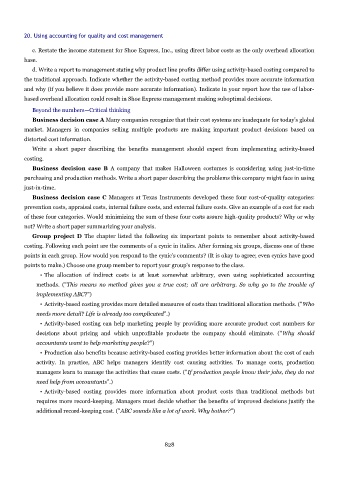Page 827 - Accounting Principles (A Business Perspective)
P. 827
20. Using accounting for quality and cost management
c. Restate the income statement for Shoe Express, Inc., using direct labor costs as the only overhead allocation
base.
d. Write a report to management stating why product line profits differ using activity-based costing compared to
the traditional approach. Indicate whether the activity-based costing method provides more accurate information
and why (if you believe it does provide more accurate information). Indicate in your report how the use of labor-
based overhead allocation could result in Shoe Express management making suboptimal decisions.
Beyond the numbers—Critical thinking
Business decision case A Many companies recognize that their cost systems are inadequate for today's global
market. Managers in companies selling multiple products are making important product decisions based on
distorted cost information.
Write a short paper describing the benefits management should expect from implementing activity-based
costing.
Business decision case B A company that makes Halloween costumes is considering using just-in-time
purchasing and production methods. Write a short paper describing the problems this company might face in using
just-in-time.
Business decision case C Managers at Texas Instruments developed these four cost-of-quality categories:
prevention costs, appraisal costs, internal failure costs, and external failure costs. Give an example of a cost for each
of these four categories. Would minimizing the sum of these four costs assure high-quality products? Why or why
not? Write a short paper summarizing your analysis.
Group project D The chapter listed the following six important points to remember about activity-based
costing. Following each point are the comments of a cynic in italics. After forming six groups, discuss one of these
points in each group. How would you respond to the cynic's comments? (It is okay to agree; even cynics have good
points to make.) Choose one group member to report your group's response to the class.
• The allocation of indirect costs is at least somewhat arbitrary, even using sophisticated accounting
methods. ("This means no method gives you a true cost; all are arbitrary. So why go to the trouble of
implementing ABC?")
• Activity-based costing provides more detailed measures of costs than traditional allocation methods. ("Who
needs more detail? Life is already too complicated".)
• Activity-based costing can help marketing people by providing more accurate product cost numbers for
decisions about pricing and which unprofitable products the company should eliminate. ("Why should
accountants want to help marketing people?")
• Production also benefits because activity-based costing provides better information about the cost of each
activity. In practice, ABC helps managers identify cost causing activities. To manage costs, production
managers learn to manage the activities that cause costs. ("If production people know their jobs, they do not
need help from accountants".)
• Activity-based costing provides more information about product costs than traditional methods but
requires more record-keeping. Managers must decide whether the benefits of improved decisions justify the
additional record-keeping cost. ("ABC sounds like a lot of work. Why bother?")
828

